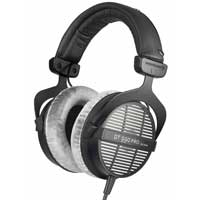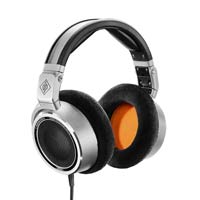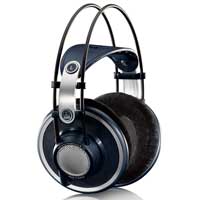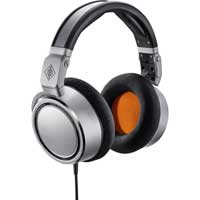Beyerdynamic DT 1990 Pro Review: Overview
Beyerdynamic DT 1990 Pro
OUR RATING:
4.8
(out of 5)
Specs
- Impedance: 250 Ω
- Drivers: Dynamic, 45 mm, neodymium
- Frequency range: 5 Hz – 40 kHz
- Sensitivity: 102 dBSPL
- Weight: 370 grams
- Cable length: 3-meter straight cable, and a 5-meter coiled cable
Pros
- Best dynamic response in this price range
- Best soundstage and imaging in this price range
- Outstanding detail resolution
- Great bass response for an open-back design
- Absolute minimal distortion
- Comes with hardshell carry case, extra cable, and additional ear pads.
Cons
- Sibilance around 8 kHz is out of balance in rare cases
- Clamping force of the headband is a bit too strong out of the box
Check Price:
US and Canada
UK and Europe
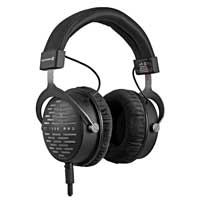
Bottom Line:
Premium reference headphones with remarkable detail retrieval, spacious soundstage, and dynamic punch.
Introducing the Beyerdynamic DT 1990 Pro
If you’re looking for a set of headphones for studio use, the Beyerdynamic cans are a very safe place to start looking. They’ve been developing dynamic driver headphones since 1924, and these decades of handiwork show in the attention to detail with all of their headphones.
The Beyerdynamic DT 1990 Pro headphones are their premium open-back reference headphones meant primarily for critical listening. The more expensive T1 and T5 models are designed primarily for hi-fi enjoyment.
Having heard only positive reviews from fellow audiophiles about these, we were curious to test drive them and see how they held up to the competition.
See here for all our headphone reviews and audio gear information.
Who are the Beyerdynamic DT 1990 Pro headphones for?
The DT 1990 Pros are for audio enthusiasts and critical listeners.
Their open-back design allows the sound to travel past the earcup, resulting in a more natural resonance. This natural resonance is why they are the preferred design for studio use.
Who are the Beyerdynamic DT 1990 Pro headphones NOT for?
Due to an open-back design, the DT 1990 Pro headphones are NOT suited for anyone in the market for a pair of headphones with good sound isolation or active noise-canceling.
The open-back design allows sound in and out. In noisy environments or for applications where you cannot tolerate sound leakage (such as tracking), these are not your cans.
These are also not consumer headphones. The frequency response is neutral, designed for critical listening.
Alternatives to the Beyerdynamic DT 1990 Pro
Open-back
Shure SRH1840
Some of our favourite reference cans with a delicate, natural sound signature.
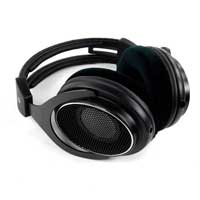
Check Price:
AmazonClosed-back
Beyerdynamic DT 1770 Pro
If closed-back is what you need, these have a very similar sound signature and performance to the DT 1990 Pros.
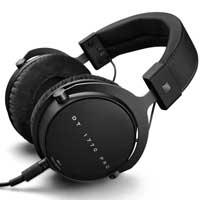
What’s in the box?
The Beyerdynamic DT 1990 Pros come with the following accessories:
- A hardshell carry case
- One straight 3-meter cable terminating in 1/8 inch connector with a 1/4 inch adapter
- One coiled 5-meter cable terminating in 1/8 inch connector with a 1/4 inch adapter
- ‘Balanced’ ear pads – made of denser foam which tend to deliver more prominent bass response
- ‘Analytical’ ear pads – made of lighter foam. When on, the headphones have ironically, more balance in the frequency response.
Unboxing Video
Build
More than any other cans in this price range, the Beyerdynamic DT 1990s feel like a premium headphone. Like all of the Beyerdynamic cans, they are sturdy and hard-wearing, but these have a luxurious feel as well.
They feel like they are cut from one stone, a single unit. The headband, an aluminum frame covered by cushy pleather, can be size-adjusted with a gentle ratchet motion.
The cable attaches only to the right ear side, which for studio use is ideal.
All of the accessories, from the case to the extra ear pads, and cables are top quality with nothing wanting.
Comfort
In terms of comfort, the DT 1990 Pro headphones rank around 8 out of 10. At first, they are comfortable, nothing touches or scrapes the head.
Their sturdy build looks heavy but is surprisingly lightweight, at 370 grams.
The earcups gave ample space to my (medium to large size) ears. Nothing inside the earcup touched my ear. On the downside, out of the box, the clamping force is a bit too tight for long sessions.
In this regard, their predecessors, the 990 pros and the Shure SRH1840, Sennheiser HD 600, and the Hifiman Sundara are all more comfortable.
Power Requirements from your Sound Source
Owing to the efficiency of the new Tesla-designed drivers, the Beyerdynamic DT 1990 Pros are very easy to drive despite their 250 Ω impedance.
They won’t achieve the best results with a battery-powered source, but to my surprise, they can be driven by a phone.
For best results, a dedicated amplifier or an audio interface with an integrated amp is still recommended.
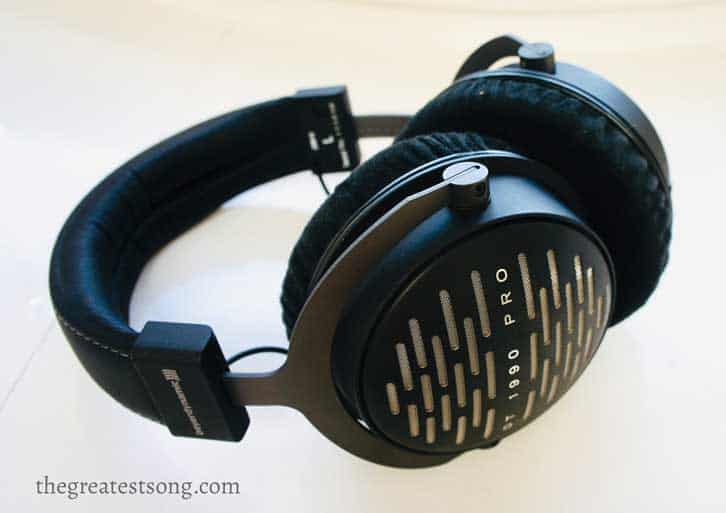
Sound
First Impressions
When I first tried these out, it is clear that these headphones have outstanding detail resolution for the purposes of critical listening, but they are more than mere analytical tools. (See our Best Headphones for Mixing post for more on this subject)
Three qualities stand out: these cans have an extensive soundstage, a satisfying dynamic punch, and minimal distortion.
In our clinical tests, we were able to identify total harmonic distortion with the Beyerdynamic DT 1990 Pros down to a whopping 0.01%.
Frequency Response
Beyerdynamic DT 1990 Pro Frequency Response Chart
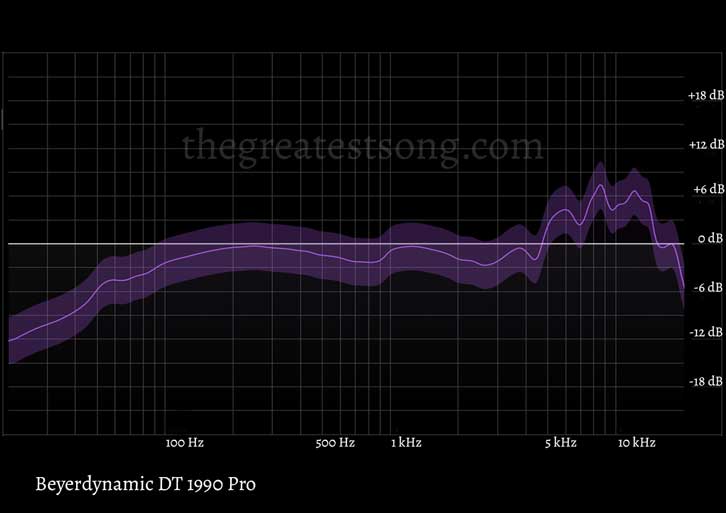
Lows
The bass response of these is superb for an open-back headphone design. The driver is further away from the ear in the 1990 Pros, so they get a natural bass boost.
It’s rare that the open-back design produces bass that is truly felt rather than heard, but the DT 1990 Pros achieve just that. The transient response of these cans is fast in general, but it is particularly noticeable in the bass.
With the ‘balanced’ pads, however, the bass is almost too enjoyable with the lower mids getting slightly drowned out. (They sound a bit like the Sennheiser HD 650s in this regard)
Thankfully, switching the ‘analytical’ earpads, the bass is not so overpowering and the mud in the middle is cleared out.
Midrange
The midrange of the DT 1990 Pro headphones comes across as extremely natural without sacrificing any detail.
Guitars sound full and present. Vocals have body to them in this range. In general, the mids are balanced with the top and bottom.
Highs
The upper frequencies on the DT 1990 Pros have produced complaints from some audiophiles. As you can see in the chart above, there is a peak around 8.5 kHz that can upset the balance on some tracks, leading to pronounced sibilance.
Most of the time, however, the top of the DT 1990 Pro headphones feels brilliant, bringing out details in tracks that are unnoticed with other headphones.
Some think the DT 1990s bring out only what is already present in the recording, some think they simply deliver poor high frequency reproduction.
In our tests, this boost in brilliance/sibilance only bothered me on particular tracks. Squarepusher’s track Iambic 9 Poetry is a live drum and bass track where the snare and hi-hat hits sit consistently in this 8 kHz area. Enjoyment of the track disappears and I’m just thinking about that hyped treble.
I compared it with the Hifiman Sundara and the Shure SRH1840 and they confirmed there was nothing wrong with the recording.
If this occurs, it can easily be solved with a little EQ correction. But as I said, on most music, imbalance is not present.
Dynamics
More than any other headphones in this same price range, the DT 1990 Pro headphones deliver a satisfying dynamic punch.
By this I mean, you can feel the weight of a pianist’s fingers on the keys, you can feel how the exact force a drummer hits the snare with, and you can feel how much chest a singer uses to belt out a note.
On our binaural tests, the test we use has an example of knocks on a door. With these headphones, each door knock has a particular force behind it that is clearly felt.
In this way, the experience of the DT 1990s transcends the analytical, because you can feel the music.
For example, in The Ride of the Valkyries played by the Wiener Philharmonic with Böhm conducting, you can feel the bat-like wings beating in the glissandi of the violins.
When I listen to this recording with the Hifiman Sundara (a great set of cans in their own right), I can hear the glissandi but I cannot feel it.
Soundstage and Stereo Image
Something Beyerdynamic cans always seem to get right is the soundstage. The DT 1990 Pros have a superb, extensive soundstage that never feels like too much. This is another area where they outclass all competition.
Whether it is a live recording of a band in a club or an orchestra in a concert hall, the soundstage feels larger, more outside the center of my head in these headphones. The club is bigger, the concert hall is bigger.
The wider stage means its easier to identify instruments in a mix because they’re not all packed in the same acoustic space.
As an added bonus, the ample soundstage gives a palpable sense of atmosphere in some tracks, that with other headphones is completely missing.
Importantly, I never felt the soundstage was overdone. It feels large, but natural. There is no adverse effect on the imaging, which was accurate without gaps in all directions.
Conclusion: Are they worth it?
The Beyerdynamic DT 1990 Pros are far better than any of their competitors in terms of dynamic punch and soundstage. Generally, they set the bar very high for headphones in this price range.
Their overall balance is exciting for reference headphones. It means you might actually enjoy the music you are editing. And for this same reason, they are not flawless as some might prefer a ‘flatter’ response.
Personally, I would take these over the Hifiman Sundaras, Edition XS, or any of the Sennheisers out there. On par with the Beyerdynamic DT 1990 Pro are the Neumann NDH 30 and the Shure SRH1840.
Beyerdynamic DT 1990 Pro

Check Price:
US and Canada
UK and Europe
How We Tested the Beyerdynamic DT 1990 Pro Headphones
As a reminder, we test everything on this site ourselves.
These headphones were tested under controlled conditions in a sound-treated room and also in a noisy household environment.
Don’t believe any ‘objective’ measurements you see about headphones! The shape of your head and ears alone will have a significant effect on frequency response and other factors. Therefore, all headphone reviews are subjective, this one being no exception.
Our comparisons for the Beyerdynamic DT 1990 headphones were limited primarily to other open-back planar magnetic and dynamic driver headphones in the same class. Although we did directly compare a few closed-back and consumer headphones just to keep our ears honest.
In addition to testing these headphones on music of all styles, we conduct extensive clinical tests on frequency response, dynamic range, driver matching, harmonic distortion, binaural tests, wiring, and stereo imaging.
Our rating assumes that you value sound quality above all other factors, followed by comfort/build, then price.
Questions or Comments?
Join the discussion here on Facebook.
